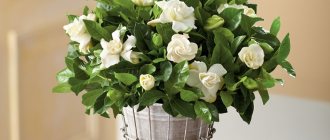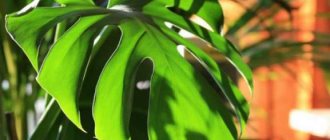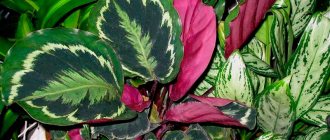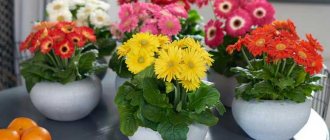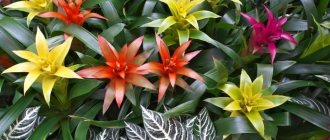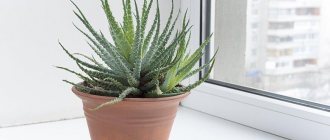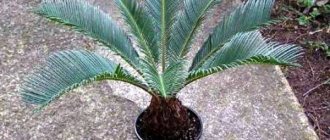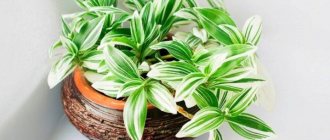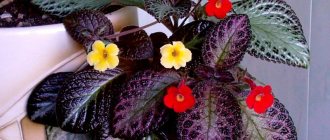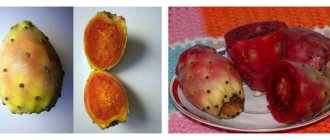Flower growers love the Dieffenbachia plant not only for its beautiful shape and leaf color, but also for its unpretentiousness and for its beneficial properties. This is written in detail in the article.
Author of the article
Maxim Sverchkov
Professional biologist and breeder with extensive experience and experience.
Also in the article you will find a photo of Dieffenbachia and a photo of Dieffenbachia in the interior of an apartment.
Location and lighting
Dieffenbachia requires a large amount of light, only then will the unusual color of the leaves be preserved.
The light should be diffused, since under the influence of direct sunlight, burns may appear on the surfaces of the leaf plates. A window sill located next to a window with east or west orientation is suitable for placement. The south side is not recommended as a placement location, however, you can also place a pot of Dieffenbachia here, protecting it from direct sunlight. For shading, use small curtains, blinds or special films that adhere to the glass. Dieffenbachia does not do well near a north-facing window because it does not have enough light. If it is not possible to place the plant in another place, arrange additional lighting by installing a special phytolamp or making a backlight using ordinary fluorescent lamps.
Lack of sunlight negatively affects the condition of the leaves: they become smaller and lose their variegated color. You should not constantly move the flower from one room to another. Dieffenbachia does not tolerate drafts: due to exposure to cold air, the leaves begin to turn yellow and fall off. During ventilation, the flower must be removed away from the source of the draft, and best of all, taken out of the room. The plant loves fresh air, so in the summer Dieffenbachia is placed on the veranda or balcony, protected from direct sunlight and wind.
Location
The best place in the house is away from the sun's rays, which can easily cause the leaves to burn and the plant will lose its decorative appearance for a long time.
If possible, place a pot of Dieffenbachia near a northeast or northwest window, or, if the windows face south, in the back of the room. At the same time, the plant needs a lot of light and long daylight hours. If there is insufficient lighting, install additional lighting.
A lack of light leads to a loss of decorativeness of the leaves - the variegated pattern is lost, turns pale, and may even disappear altogether, leaving room only for a dark green color.
Diseases and pests of Dieffenbachia
It should be noted that diseases and pests can colonize the flower if Dieffenbachia care does not meet the requirements. A strong plant itself resists diseases. Of course, you can populate insects from a neighboring flower or use soil with living fungal mycelium for replanting, but this only means that the care of the plants on the windowsill is poor.
Signs of fungal diseases are the appearance of uncharacteristic spots, stripes, and weeping and drying leaf edges on the leaves.
When the root system rots, it cannot provide the plant with nutrition, and yellowness appears on the leaves.
This makes itself felt by diseases such as:
Anthracosis attacks the upper part of the plant. The appearance of dry spots that enlarge and destroy the leaf is the most characteristic manifestation of the disease. Spores can get in with irrigation water. The disease is caused by dry indoor conditions and excessive watering. You can treat with fungicides and remove the infected parts of the plant. Normalize the regime of detention.
Fusarium spreads to the roots and the entire plant. The mushroom lives in the soil. Therefore, it is important to sterilize the substrate when replanting a plant. You can save the plant at the earliest stage of the disease by treating it with a fungicide, cutting out the affected areas and taking new dishes and soil.
The viral disease manifests itself as curled leaves and a bronze tint on the top of the plant. Carried by insects from diseased plants. The diseased plant must be destroyed. You cannot take material from him for reproduction.
Insect pests that have colonized the flower feed on the juices and spoil the appearance of the flower. If the colony becomes large, it can kill the plant. Several types of pests reproduce on the poisonous Dieffenbachia:
Measures to combat them are known - first, soapy water, later - insecticides.
Recommendations for cultivation and care
In order for the cultivation and care of Dieffenbachia to be successful, it is necessary, in addition to observing agrotechnical rules, to remember that:
- this plant has toxic juice, so it should be handled with rubber gloves, and points of damage to the stem or leaves should be immediately blotted with a rag, removing the released juice;
- when pruning any parts of the bush for subsequent propagation, it is necessary to disinfect the cutting tools with alcohol, and sprinkle the cut areas with crushed charcoal;
- the container with water in which the cuttings are placed for germination of roots should be in a warm place, but in no case under the influence of sunlight;
- It is not recommended to fill a jar with several cuttings, as this may cause them to rot;
- when dividing the root system for subsequent propagation, care should be taken to damage the root shoots;
- When planting seedlings, do not use overly spacious or overly cramped containers.
Cultivated for a century and a half, Dieffenbachia not only has not exhausted its decorative resource, but is also conquering new areas in rooms where people live, work or relax.
Caring for You: Simple Tips
Dieffenbachia at home can not only grow, but also bloom, bear fruit and reproduce in various ways.
How to water Dieffenbachia? The main thing is not to over-moisten the soil. Dieffenbachia should be grown in flowerpots with good drainage and in soil of a special composition containing 1 part sand, two parts peat, two parts turf soil and 1 part humus. Carefully check the turf for the presence of insect larvae and worms, so that later you don’t have to look for the reason why the leaves are drying or whether the plant has a mysterious disease. For drainage, it is better to use expanded clay or broken brick.
One of the secrets of how to care for Dieffenbachia is the correct placement of the plant relative to the light source. When growing different varieties, we try to orient rich green plants closer to the window, variegated ones and with large white splashes - to shade them or place them in the far corner. Variegated varieties grown in bright light can easily lose their decorative properties.
Periodically, the leaves on the plants need to be wiped. It is recommended to use a damp cloth, and since the plant is poisonous, this procedure is best carried out with gloves. Dieffenbachia can be easily washed at home using a terry sock placed on your hand. We settle the water in a bucket (ideally, we take boiled or even distilled water, so as not to leave white stains on the leaf), rinse our hands in the bucket and evenly wipe the entire area of the leaf, without fear of getting the plant juice on the skin.
By the way, the benefits and harms of Dieffenbachia are the subject of debate among amateur florists: is it possible to keep a planted flower with a dubious reputation at home?
All tropical plants are poisonous to a greater or lesser extent. If Dieffenbachia juice fails to get on the skin, irritation in the form of redness may develop, and contact with the eyes can cause temporary blindness. Of course, Dieffenbachia should be kept away from small children. But it brings much more benefits than expected. It turns out that Dieffenbachia at home has a unique ability to purify the air from benzene and fromaldehyde, turning the atmosphere of a city apartment into the cleanest air of the Amazon.
With reasonable care, we can enjoy this majestic plant that turns our home into a green kingdom.
Reproduction by drops
Amateur flower growers with sufficient experience and skills practice such an original method of propagating and renewing an ornamental crop as digging in the apical shoot of an adult plant. In this case, the stem part of the stem with the presence of buds is laid flat and dug in. When the event is carried out correctly, not one, but several young plants sprout in one row, which looks very attractive and impressive.
Rules for caring for Dieffenbachia at home
The tropical guest tolerates and forgives many mistakes of beginners. Dying specimens quickly take root and easily succumb to “reanimation” conditions. But you shouldn’t test the strength of such a beautiful culture. Full care for it consists of creating a moist environment, timely feeding and pruning the stems.
How to properly water and spray Dieffenbachia
Caring for Dieffenbachia flowers at home requires special attention to water procedures. The plant reacts painfully to lime, so the water for watering and spraying must be well settled. You can filter or boil it, or use rainwater.
Abundant watering in summer and moderate in winter is required. The culture does not tolerate excess moisture. In order not to provoke rotting of the rhizomes and stems, make sure that the soil in the pot does not resemble liquid mud and does not dry out. It is advisable to alternate watering (from the top and through the pan). At low temperatures, it is better to replace spraying by washing the leaves.
When and how to feed Dieffenbachia
The flower grows quickly, using the entire reserve of substances necessary for its formation.
Fertilize it in the spring-summer period up to three times a month. Fertilizers are applied to choose from: liquid mineral or organic
.
By the way, some types of Dieffenbachia with white leaves lose this varietal feature, turning into rich green ones, due to the nitrogen content in complex fertilizers.
Features of plant transplantation
The optimal period for transplanting Dieffenbachia at home is February - May. The procedure should be carried out as the root system grows, sometimes even a couple of times a year.
To do this, choose a container with a diameter several centimeters larger than the previous one. An impressive layer of coal is placed on the bottom for fertilizer and drainage, the earthen tuber with the plant is carefully transferred, damaged roots and adhering drainage residues are removed. Sprinkle fresh slightly acidic soil on top and water.
How to prune Dieffenbachia
When you already know how to water and what to feed Dieffenbachia at home, you need to find out the rules for regular pruning of the plant. Under favorable conditions, the plant produces a new leaf every week, exposing the lower part of the stem. As a result, the indoor beauty loses its decorative effect.
Important! To select a sprout for planting, any part of the Dieffenbachia stem is suitable. It can be carried out at any time of the year, remembering that:. the plant is poisonous (to avoid contact of toxic juice with the skin, all work must be carried out with gloves); pruning is carried out only with a sharp knife, which is pre-treated with alcohol; when working with Dieffenbachia, you need to protect your eyes so that poison does not splash; the juice that appears is removed by wiping it with a soft cloth, and for disinfection, the sections are treated with crushed charcoal; After work, hands should be washed with soap.
the plant is poisonous (to avoid contact of toxic juice with the skin, all work must be carried out with gloves); pruning is carried out only with a sharp knife, which is pre-treated with alcohol; when working with Dieffenbachia, you need to protect your eyes so that poison does not splash; the juice that appears is removed by wiping it with a soft cloth, and for disinfection, the sections are treated with crushed charcoal; After work, hands should be washed with soap.
Important! In stem species of Dieffenbachia, the stem is radically cut off once every 3-4 years, leaving a stump of no more than 10 cm. And in bush species, only damaged and dried leaves are removed.
How to care for Dieffenbachia (video)
All indoor Dieffenbachias, regardless of varietal characteristics and type, are fast-growing and highly decorative plants that do not have side shoots as such. The foliage is attached to the stem by cuttings. Flowering is observed in the first ten days of spring, but for a young plant this process is undesirable, so it is very important to promptly remove all blooming flowers. Low-growing varieties and hybrid forms are able to grow well and form bushes with dense foliage, which makes it possible to use Dieffenbachia very widely when decorating a room interior.
Where is the best place to place Dieffenbachia?
Due to its ability to purify the air from formaldehyde, trichloroethane, xylene and benzene, the flower is recommended to be placed in areas with unfavorable ecology - that is, areas heavily polluted by industrial and automobile exhausts. At home, there is no better place than the kitchen for a flowerpot, especially if its windows overlook a busy road.
If you follow the rules of Feng Shui, a corner near a desk is perfect. This evergreen inhabitant of the tropics humidifies the air well, neutralizes microbes, and has a beneficial effect on the nerves. But in addition to its positive qualities, superstitions say that the plant takes away male power. That's why he's feared in bedrooms.
What kind of lighting does Dieffenbachia need?
When wondering how to grow Dieffenbachia, you should not forget about the peculiarities of the climate of its homeland. A lot of heat, light and moisture is all that a flower needs for full growth in indoor conditions. Moreover, the more spots on the leaves, the more light you give them.
Did you know? The indoor Dieffenbachia from the genus Araceae received its name from an Austrian botanist in honor of the senior gardener of the Vienna Botanical Garden, Joseph Dieffenbach.
It is important to avoid direct exposure to sunlight, which takes away the plant’s brightness and wilts it. At the same time, the light must be diffused
The ideal distance would be a meter or two from the window on the sunny side. If you have the opportunity to additionally organize artificial lighting, the pot can be moved further away.
Temperature regime for the plant
This is the next whim of the fastidious Tropican. It does not tolerate drafts, reacting to them with intense loss of foliage and wilting. In summer, the room where Dieffenbachia grows should be between 20 and 30 °C, and in winter not lower than 15 °C, otherwise do not be surprised by the sudden yellowing of the leaves.
Also avoid sudden changes in temperature. especially if you are going to transport your green pet somewhere. In winter, do not place heating devices nearby. Dieffenbachia loves fresh and moist air.
What should the air humidity be for successful growth?
Knowing what Dieffenbachia loves, it is important to ensure that the humidity in the room does not fall below 65%. Of course, in winter it is difficult to maintain such a standard in an apartment with central heating.
To do this, experienced florists recommend spraying and washing the leaves with warm water, the more often the better. Small flowerpots can occasionally be given a shower (not cold) by covering the soil in the pot.
Leaf propagation
Relatively rarely, in indoor floriculture, propagation of Dieffenbachia by leaf is used . The process of such reproduction takes a lot of time, and also does not guarantee one hundred percent survival of planting material. As a rule, several completely healthy and well-formed leaves with intact petioles, cut from the apical part of the plant, are treated with growth stimulants and rooted in water. Propagation by the lower, largest leaves involves rooting in the soil mixture in an indoor mini-greenhouse in compliance with the optimal temperature regime and a comfortable humidity level.
Caring for Dieffenbachia at home: watering and lighting
The location for placing Dieffenbachia is chosen to provide bright lighting without direct sun. In winter, it can grow well in partial shade, away from the window, subject to additional lighting. It is good to place a flower near a window covered with a tulle curtain.
A distinctive feature of the culture is its heat-loving nature; the growing temperature of Dieffenbachia should not be lower than 18 °C; in summer it is 18-24 °C, with a maximum of up to 30 °C. In winter, the plant can briefly tolerate a decrease to 10-12 ° C, but this will certainly affect its appearance, causing yellowing of the lower leaves. Optimal for the winter period is 17 °C, with minimal differences between day and night. You should not place the flower near heating appliances. Dieffenbachia loves fresh air; in the summer it can be located on an open balcony or loggia, if it is possible to provide it with shade and no drafts. The crop does not tolerate the latter and immediately reacts to them by yellowing and falling leaves, so it is better to take the flower out of the room even while airing.
When watering Dieffenbachia, certain rules must also be followed. This tropical crop is moisture-loving, but does not tolerate waterlogging, which causes root rot, especially at low temperatures. The earthen ball should be moderately moist, but not wet; watering is done with warm, settled water only after the top layer of soil has dried.
Decorative Dieffenbachia in the photo
Like any fast-growing flower, the crop needs regular feeding; during the period of active growth from May to August, they are carried out every 10-14 days, in winter and autumn - once a month or less. A weak solution of complex flower fertilizer is used as a fertilizer for Dieffenbachia; fertilizing with nitrogen-containing organic matter is also useful. With a lack of nutrients, the plant sheds its lower leaves and exposes the trunk, and also loses its brightness of color.
To successfully grow Dieffenbachia, home care must necessarily include measures to increase environmental humidity. Due to the large surface of the leaf plates, the flower suffers greatly from dry air. The optimal humidity at which the plant feels good is at least 60-70%. Obviously, it is impossible to create such a microclimate in an apartment with central heating, so daily spraying is used to increase humidity; it is also useful to wipe the leaves with a damp cloth or sponge once every 2 weeks. For these procedures, warm boiled water is used; hard tap water causes plaque to appear on the sheets and they lose their decorative properties.
When spraying, you must pay attention to the absence of drafts and air temperature, otherwise, instead of benefit, you can cause harm to the delicate flower. Even at +18 °C, it is better to replace spraying with wiping
The culture develops and grows all year round, requiring constant temperature in summer and winter, however, according to experts in growing indoor Dieffenbachia flowers, caring for them in winter should provide the plants with a period of rest. At this time, watering and fertilizing are limited, which makes it possible to avoid the appearance of small leaves due to insufficient lighting.
It should be noted that for stem and bush Dieffenbachia, the care is almost the same, differing mainly only in the volume and regularity of pruning, which will be discussed in detail below.
What does Dieffenbachia look like, what family does it belong to?
The flower belongs to the Araceae family.
The homeland of Dieffenbachia is South and Central America, where the flower grows in tropical forests. The name is given by the name of the German botanist Joseph Dieffenbach.
Young Dieffenbachia in a pot
Description of appearance:
- The stem is large and juicy.
- The leaves are oval-shaped, massive, or elongated oval. The color of the leaf blades can be any, depending on the variety - white or green, with or without edging, spotted or plain. The location is alternate.
- The height of an adult tree is about 2 m.
- The inflorescences are inconspicuous and do not carry any decorative characteristics.
Additional Information! With age, the trunk becomes bare, so once every few years it is recommended to trim the top for the purpose of rejuvenation.
Common varieties
Dieffenbachia is divided into many varieties, which differ in their appearance:
- Seguina - wide leaves with a diameter of about 16 cm, few lateral veins.
- Oersted - the shape of the leaf blades is pointed, heart-shaped, length from 30 to 35 cm. A distinct central yellow vein runs through the middle.
- Vesuvio is an elegant tree, the leaves are narrow and medium in size. There are green blotches on the leaf blades.
- Camilla is a bushy, hardiest variety. The leaves are lanceolate, creamy white, with a pale green rim along the edge.
- Compacta is a small, neat bush. Along the leaf plate there is a central vein and light inclusions.
In total, Dieffenbachia has about 50 subspecies, but only some of them are in greatest demand among flower growers.
Bush or large-leaved Dieffenbachia - decoration of any interior
Caution: the plant is poisonous
There is an opinion that Dieffenbachia is a highly poisonous flower, and therefore it is not recommended to keep it in a house where there are small children. This statement is partly true.
Indeed, the juice, if it comes into contact with the skin, can cause an undesirable reaction in the form of redness and itching. A slightly stronger reaction may occur in people prone to allergies.
If the juice gets on the skin, causing redness on it, just rinse it under running water.
However, the plant is not so poisonous that it should not be kept at home. It is enough to follow the basic rules of caution and there will be no troubles.
Additional Information! In the homeland of the flower, its juice is used as a poison to kill rats.
Any care manipulations must be carried out with rubber gloves.
Dieffenbachia: care at home
When caring at home, Dieffenbachia requires compliance with temperature and light conditions, watering, fertilizing and protection from pests.
Temperature
Comfortable conditions for a flower in summer are 22-25 degrees, in winter – 16-18 degrees. He is afraid of drafts, in the summer he needs to be put on the balcony - because of his love for clean air. Keeping a flower in direct sunlight is dangerous - its foliage will burn and unsightly defects will appear on the plates.
Lighting
The Dieffenbachia plant needs bright light - only with it it grows quickly and produces beautiful spotted leaf plates. Direct exposure to sunlight can cause burns and further illness.
Important! If there is no sunny room, there is no need to worry - the plant is a shade-tolerant species.
Watering
The shrub requires regular moistening; dust must be wiped off the foliage weekly using a damp cloth.
Leaves need to be wiped regularly
Spraying
In spring and summer, the plant is periodically sprayed and given a shower. In order not to provoke excessive moisture, the lower part is covered with plastic wrap before the procedures.
Humidity
The houseplant grows well in high humidity levels. Due to this feature, it is necessary to constantly care for it: regularly spray it, and place an aquarium next to the box.
Important! In winter, humidification is increased due to drying of the air by heating devices.
Priming
Flower shops offer a special mixture designed for Dieffenbachias. If desired, you can make a nutritious soil mixture with your own hands: take 1 part sand, humus and 3 parts earth.
Feeding
Caring for Dieffenbachia involves adding nutrients. Regardless of the variety, the shrub is characterized by rapid growth, which requires a lot of effort. Restorative feeding in the summer months is carried out every 7-10 days. The plant prefers a nitrogen-organic mixture and special additives intended for variegated species.
Less popular methods of reproduction
Despite the fact that the process of cutting Dieffenbachia is very quick and quite easy, there are other possibilities for propagating an indoor ornamental plant. Along with ficuses, Dieffenbachia can also reproduce using air layering.
For this purpose, it is necessary to make an incision on the stem part, which should be covered with well-moistened moss. On top of the moss it is necessary to wrap dark polyethylene, which must be sealed tightly with tape, tape or thread slightly above and below the cut area. After the roots have formed under the film cover, the stem part with roots and film must be cut off, the winding removed and planted in a nutritious soil substrate.
Botanical characteristics
Growing an indoor evergreen herbaceous plant is not too difficult. The plant has thick and straight, fairly fleshy stems and large, oblong, glossy or matte alternate leaves. Varieties with green or variegated foliage are well known. Variegated species have an attractive appearance, and the leaves are covered with a pattern represented by light green or yellow specks, stripes and spots. It is thanks to its high decorative value that the plant is in great demand in indoor culture.
Particularly popular are Dieffenbachia spotted and Dieffenbachia variegated, which became the progenitors of a large number of hybrid forms that differ in size and color of leaf plates. The indoor flower is characterized by rapid growth rates. Proper cultivation and creation of comfortable conditions allows the plant to form one new leaf every week. The upper part of the shoot has a growth point, but at home the height of an adult indoor flower varies between 0.5-2 m. Some varietal varieties have dormant buds, the awakening of which causes the plant to tiller.
Over time, the foliage on the stem part turns yellow, dries out and falls off, which causes the trunk part to become exposed, and the plant becomes like a palm tree with succulent, variegated leaves at the apical part. If the plant loses its decorative qualities, it needs to be re-rooted. Some types require mandatory updating every three years.
Dieffenbachia blooms in mid-summer, but in the conditions of indoor floriculture, the ornamental crop acquires flowers extremely rarely. Along with other representatives of the Aronia family, Dieffenbachia flowers are small in size, yellowish-white in color, and completely inconspicuous. Then small and bright, orange-red berries ripen on the plant. This process provokes inhibition of growth and shedding of the lower foliage, so experienced amateur gardeners remove the buds completely.
Plant characteristics
In its homeland, South America, Dieffenbachia, named after the Austrian botanist J. Dieffenbach, reaches a height of two meters. At home, it is not so tall, but it is just as impressively decorated with beautiful dark green large leaves with white and beige streaks.
They are attached to a powerful stem, similar to a tree trunk, which grows quite quickly under optimal conditions.
Did you know? During slave-owning times in the United States, offending slaves were often punished with
toxic Dieffenbachia juice , which caused serious suffering to those punished.
A characteristic feature of this indoor plant is the presence of poisonous juice, which is released when the leaves or stem are damaged and can cause severe burns to the mucous membranes and skin of humans and animals.
Transplantation and propagation of Dieffenbachia
Young plants can be replanted once a year
It is important to select the next container correctly. It is recommended to take a pot a couple of centimeters larger than the previous pot
Adult specimens should be disturbed much less frequently and replanted only every 4 years.
Dieffenbachia transplant
Replanting a plant requires care and caution. It is best to act according to a certain algorithm so as not to harm Dieffenbachia
- Take a new pot for Dieffenbachia and place a drainage layer on the bottom.
- Place a small amount of soil on top.
- Remove the plant from the pot and carefully examine its roots. If defects are found on the roots, it is best to cut them off. The cut areas will need to be treated with activated carbon.
- Without shaking off the soil, you need to move the Dieffenbachia to a new pot.
- Fill the sides with soil and water the flower.
When the plant has reached a large size, you should not send it to a new, deeper container. It will be enough to update the top layer of soil.
In order to learn how to propagate Dieffenbachia at home, you need to study 4 different methods:
Seeds. This method is used by specialist breeders to develop new varieties. Seeds are obtained by hand pollinating male and female flowers.
Top cuttings. When the plant is stretched upward and the stem has no leaves, the top is cut off. It is placed in water or a peat-sand mixture. During the growth process, it is recommended to spray the cuttings and protect them from direct rays.
Stem pieces. The pieces are cut into several cuttings up to 20 cm in length. They are dried for 2 days and then placed in a substrate of sand and peat. After this, the container is covered with film and remains at a temperature of +25 degrees for 6 months.
Propagation of Dieffenbachia by stem pieces
Layerings. A cut is made on the stem and wrapped with film. All this is fixed with tape or thread, and after that you can observe the appearance of roots, which are cut off and planted in a separate pot.
How does Dieffenbachia reproduce?
Even a novice gardener can cope with the propagation of Dieffenbachia. You just need to follow simple step-by-step agricultural techniques.
Dieffenbachia flower - home care
Speaking about how Dieffenbachia reproduces, we need to mention the seeds. It is difficult to obtain a ripened fruit at home. But if this succeeds, you can try to propagate the plant by sowing. To do this, seeds are sown in flat pots on moist soil and the container is covered with film. The container should be in a warm place. Every day the greenhouse is opened, ventilated and the soil surface is watered. With proper care, seedlings will appear in 14-20 days. After several leaves appear, the seedlings need to be planted in separate pots.
Attention! Growing Dieffenbachia from seeds is a very difficult process for amateur flower growers. In this way, breeders obtain new plant varieties.
Rooting cuttings
Cuttings are cut from the main long trunk or young but strong shoots. The branches are cut into segments with 2-3 internodes and kept for several hours in a root former solution. Then they are buried in the ground in shallow containers and watered as needed.
Non-lignified shoots can be placed in a glass of water for germination. You can wait several weeks for the first roots to appear. After the root part has formed, the sprouts need to be planted in the ground.
It is important to remember the poisonous properties of Dieffenbachia and carry out planting work with gloves. Cuttings, like other types of propagation, are carried out in the summer.
Preparing cuttings for germination
Air layering
By learning how Dieffenbachia reproduces, gardeners can use side branches to propagate the flower. To do this, young shoots are bent to the ground and buried horizontally in the pot of the mother plant. Each bud will later produce a sprout that can be rooted in a separate flowerpot.
Other options
Old bushes can be propagated from the top of the stem. To do this, cut off the top part of the plant along with the leaves and place it in water until the first roots appear. The workpiece is planted in a nutrient substrate.
Transfer
The procedure is carried out only in the summer. Update mode – 2-4 years. Old bushes about a meter high are difficult to remove from the flowerpot, so only the top layer of soil is replaced.
Sometimes the bush is transferred to another pot when the roots of the tree no longer fit in the old one. The new container should be several centimeters wider. Before transplanting Dieffenbachia, prepare a nutrient substrate, which must be moist. The first few days the plant gets used to the new container, it is not watered, and is provided with 12 hours of daylight.
Dieffenbachia transplant
Plant care
Caring for Dieffenbachia at home includes basic agrotechnical measures: watering, pruning, fertilizing and replanting.
Watering and fertilizing
You need to start with water quality. Boiled or settled water should be used not only for watering, but also for spraying and wiping the flower. Hard water can cause leaf tips to drill and fall off. Oxalic acid will help soften the water. You can use non-cold rainwater. If you want to wash the plant in the shower, the water should be slightly warm and not get into the soil. Dieffenbachia needs to be watered regularly, and in summer also abundantly. The soil should not dry out, but a swamp is not welcome either. Winter watering should be more modest; the quality of the soil can be taken as a guide. In summer, the flowerpot is watered several times a week; in winter, as a rule, once is enough. Since the flower does not have a clearly defined dormant period, it can be fed all year round, taking into account the fact that in spring and summer, fertilizing needs to be done more often and it should be more varied.
During the active phase of the growing season, the plant is fertilized twice a month, in winter - once every month and a half. Of course, special complex fertilizers are best, but you can use others, the main thing is that they do not contain lime. The best option would be a liquid fertilizer with mineral and organic nitrogen-containing elements. Nitrogen is not suitable only for white leaf varieties.
Trimming and shaping
Dieffenbachia, like any other actively growing plant, needs formative pruning, otherwise soon instead of a neat bush flowerpot (size does not matter), you will end up with a neglected riot of leaves.
Even the smallest and neatest bush needs to be updated. And there’s no need to remind you that you need to cut off a dried or damaged leaf. Before you start pruning or just want to shorten a little, take care of safety
Trimming Dieffenbachia is not difficult, but it is important to know how to do it correctly and safely. Damaged sheets must first be blotted to prevent toxic juice from getting into the eyes or skin (it is recommended to use medical gloves for work)
The pruning knife must be sharp and disinfected. Then the leaf is cut off completely, if necessary with part of the trunk. The sections are also blotted and sprinkled with crushed coal.
The plant is replanted almost annually, the need depends on the growth rate. The signal for the need for the procedure is that the pot becomes too tight for the roots. The bush is replanted at the end of winter or early spring; a plant transplanted in summer may not take root. Since the roots of the flower are fragile and brittle, it is better to replant using the transshipment method, together with a lump of earth. In a new container, slightly larger (slightly), you need to place a new drainage.
Only old bare plants need pruning. You can buy the substrate ready-made or prepare it yourself. To do this, you will need leaf soil, peat, humus, sand and birch charcoal, which will cleanse the soil of excess salt. At first, a growth stimulator is added to watering.
Reproduction
There are several ways to propagate the plant: apical cuttings, stem and air layering. Propagation by cuttings is the most popular method. To do this, the cut bare parts are blotted and placed in any nutrient medium (water, moss, peat). The temperature should be moderate, about +22 °C, and the plant should not be exposed to direct sunlight. You also need to take care of spraying. When the roots have grown a few centimeters, they can be planted.
How it blooms
Like many ornamental plants, deffinbachia tends to bloom. But such a process is considered not very favorable.
The inflorescence must be cut off, otherwise the growth of the flower will slow down significantly, and the leaves will gradually begin to fall off . Because he will direct all his strength to the development of the inflorescence.
Eventually, new old leaves will fall off, and new ones will not be able to grow. The trunk will become bare, which is why the bush will simply lose its beauty. Therefore, as soon as a bud appears, it must be removed with scissors.
Definbachia is called a natural filter. It is so necessary in large industries with a large number of harmful microelements floating in the air. And when growing it at home, you should not forget about precautions so as not to harm the health of your loved ones and pets.
How to properly replant and care for Dieffenbachia, see the following video:
Possible problems in cultivation and diseases
Violation of the requirements for caring for ornamental trees often leads to the development of diseases. Sometimes the problem is due to pest attacks. It is immediately clear what a diseased Dieffenbachia looks like: all manifestations are reflected on the foliage.
The leaves of a diseased flower are usually damaged
Drops buds and leaves
If the bush is actively getting rid of foliage, then the phenomenon is associated with rot. It is caused by excessive humidity. You can check the assumption by the state of the soil mixture: even with rare or absent moisture, it does not dry out completely. Treatment consists of step-by-step cutting of the affected root system and sprinkling the cut areas with activated carbon.
The leaves are turning pale
The fading of usually bright and colorful foliage is associated with exposure to direct sunlight. The flower must be moved to partial shade, all damaged leaf blades must be cut off - they will not be restored.
The tips of the leaves are drying out
Drying of the tips of the plates is the first alarm bell, which may be followed by massive drying out of the foliage. If the feature appears in an adult plant, then the causes include natural aging processes. In cases where the entire flower has begun to dry out, the source of the problem may be:
- insufficient spraying and moistening;
- increased air dryness;
- hot weather.
Important! Ignoring the problem of artificial drought often ends in the death of the flower
The lower leaves fall off
Rapid growth causes yellowing and loss of foliage at lower levels.
Attention! If the leaf drop affects the entire plant, then it is trying to report drafts or too low a room temperature
Pests
The main problem of the bush is attacks by spider mites, mealybugs, scale insects and aphids. What is the main sign of an attack: the leaves begin to turn yellow and become covered with foreign matter. A small number of pests are removed with a wet sponge, which is pre-moistened in a soap solution. In other cases, it is necessary to use special preparations sold in flower shops.
Other problems
Rooting of the root system is associated with an excess of incoming liquid, absence or insufficient drainage. Rotten areas must be cut off, and in case of complex damage, the upper part of the plant is separated and rooted. The lower lobe is discarded.
Caring for Dieffenbachia flowers at home is not considered difficult. Compliance with the requirements for watering, temperature and lighting will help you constantly admire the decorative flower, and not treat it.
vote
Article Rating
Possible problems during cultivation
When breeding Dieffenbachia, many gardeners encounter some problems.
The leaves are turning yellow
Yellowing of leaves is most often observed when the temperature is disturbed. This problem usually occurs in an excessively cold room or when the crop is exposed to a draft. Also provoking factors are the use of hard water for irrigation or a deficiency of useful elements in the soil. Root rot can also cause yellowing of leaves.
The leaves are curling
This problem occurs when using cold water for irrigation, exposure to drafts, and temperature fluctuations. Attacks of harmful insects are also provoking factors.
Leaves are drying
If old leaves dry out, Dieffenbachia should be rejuvenated. To do this, it is recommended to trim and root the top. When young leaves wilt, one may suspect increased dryness of the soil or temperature fluctuations. Problems can also be caused by cold air, direct exposure to the sun's rays, or a lack of fertilizers.
Drops of water accumulate on leaves
If drops of water periodically appear on the leaves of Dieffenbachia, this is considered absolutely normal.
Doesn't grow
If the development of culture is disrupted, it is worth looking for problems in temperature and lighting. Air humidity is of no small importance. In hot weather, the plant should be sprayed.
Falling leaves
This problem may be due to lack of moisture. It can also be caused by a pot that is too tight.
The ends of the leaves dry out
Wilting and dry leaf tips are most often observed at low temperatures. Drying out soil also leads to similar problems.
Loss of brightness of sheet coating
If the leaves take on a pale tint, this indicates an excess amount of light. Also causing problems is an excessive amount of phosphorus in the soil.
Reproduction technology at home
To understand how Dieffenbachia reproduces, you need to know that the vegetative method involves the use of:
- cuttings;
- leaves;
- tops;
- stems;
- shoots;
- roots.
Alocasia large-rooted is well suited as a neighbor for Dieffenbachia.
Cuttings
Young parts of a light green stem 10 cm long are used as cuttings. They take root either in water or in a substrate. When using water for rooting purposes, part of the cutting is placed in it.
The water is disinfected with activated carbon, and to stimulate the rooting process it is useful to enrich the liquid with a few drops of aloe juice. To avoid rotting of the cuttings, the water should be replaced with fresh water every week.
After about half a month, the first roots will appear on the cuttings. When they reach a length of 2 cm, the cuttings are planted in the ground, deepening them by 2-3 cm.
To successfully root cuttings immediately in the soil, you should:
- Prepare a quality cutting.
- Dry it overnight.
- Immerse it in a stimulating solution (for example, Kornevin) for 7–9 hours.
- Plant the cuttings in the soil to a depth of 5 cm.
- If the surrounding air is cool, cover the container with the cuttings with a transparent film to create a greenhouse effect.
Leaf
This method of plant propagation involves the following actions:
- Select a high-quality leaf from the plant with an intact surface and bright color.
- Cut it and dry it overnight.
- Place in a container with water.
- When root shoots (2 cm long) are formed, the leaf is planted in the prepared soil.
Top
It is also a cutting, but cut from the top of the bush just below the last bud. This method of propagating Dieffenbachia allows you to quickly obtain an adult plant with all its decorative advantages. However, the original plant can no longer be preserved.
Therefore, this method is used mainly in cases where the plant has lost its lower leaves with age, or has discovered root rot. Sometimes in this way you can save a bush affected by diseases.
In order for propagation by the tip to give a good result, you need:
- Carefully cut off the top of the bush below the top bud.
- Immerse the lower fragment of the top in a container with water enriched with activated carbon.
- At ambient temperatures below +22 °C, heat the water.
- Replace old water with fresh water weekly.
- When the roots are 3 cm long, plant the sprouted top in the prepared soil.
stem
This method is predominantly rejuvenating in nature and is used when the leaves begin to fall, exposing the lower part of the trunk, and the leaves on the middle “floor” of the plant turn yellow. To root the stem, you need to find the growth point from where the leaves begin to diverge. The stem is cut 7 cm below this point.
Did you know? Designers claim that the coloring of the leaves of different varieties of Diefenbachia is so diverse and original that these plants are suitable for decorating any room decorated in a variety of styles.
Then you need to:
- Dry the cut stem (about 24 hours).
- Bury it in the prepared soil.
- Create greenhouse conditions using transparent film.
- Wait for the stem to sprout (it does not sprout immediately, sometimes you have to wait six months).
By shoots
This method of propagation is advantageous in that the entire plant is rejuvenated at the same time. Side young shoots that interfere with its development are removed and at the same time used for flower propagation.
To do this you need:
- Cut off a shoot with a pair of young leaves.
- Place it in a container with water previously enriched with activated carbon.
- Changing the water weekly, wait for the root shoots to germinate (they should be 2–3 cm long).
- Plant the seedling in the prepared soil, keeping in mind that a sprouted shoot is already an almost full-fledged plant.
Dividing the roots
Since Dieffenbachia feels equally uncomfortable both in an overly spacious container and in a cramped one, its next transplant can be combined with propagation through root division.
To this end:
- Release the bush with the earthen lump from the container.
- Wash the roots in running water, while unraveling them.
- If root shoots damaged by rot are found, they are cut off, and the rest are treated with a low-concentrated solution of manganese or water with activated carbon.
- Leave the root ball divided into several parts to dry for a day.
- Plant the shoots in the prepared soil.
What you need to know about Dieffenbachia transplantation
Dieffenbachia transplantation is carried out annually in the spring. To do this, take a pot slightly larger in size than the previous one with holes in the bottom, pour a layer of drainage and prepared soil into it.
Dieffenbachia is carefully removed from the container, the roots are cleaned and inspected. If there are rotten places, they need to be removed and treated using activated carbon.
The plant is placed in a new pot with the trunk slightly recessed so that new roots can form. After this, watering is carried out with a solution of a growth stimulator (kornevin and others).
Although rooting Dieffenbachia is not a very simple process and can take quite a long time, if it is carried out successfully, you can get several copies of this amazing plant at once.
You can learn how to replant an azalea yourself from this article.
And you can find out how vriezia reproduces at this address: https://cvetolubam.ru/vriezia/
You can study the process of reproduction of Dieffenbachia visually by watching the following video:
Popular types
The popularity of this decorative flower culture is directly related to its luxurious appearance. Large leaves with typical bright yellow, greenish stripes and spots can transform the most inconspicuous room. Any type of Dieffenbachia looks great in a home environment or the interior of a public institution. And, most importantly, they do not require special care.
Each of the species of this tropical plant (and there are more than 40 of them) has a significant difference in color and has a unique beauty. But still, its brightest representatives received greater recognition and prevalence:
- Oersted's Dieffenbachia oerstedii is a crop with a dense, evenly colored crown. Its distinctive feature is slightly elongated, pointed leaves with a uniform green color and a wide central vein.
- Dieffenbachia seguine has a characteristic greenish stalk with white patches throughout the base. Large leaves are oblong, slightly rounded at the base.
- Dieffenbachia bausei is one of the most popular shrub plants with a strong tree-like trunk. Even with normal care, it grows 1 m in height, and the wide light green leaves have a characteristic “marble” pattern.
- Dieffenbachia maculata is the true queen of the tropics. On its dense, well-developed trunk, a luxurious crown is neatly located - the main trump card of this flower culture. Skillfully decorated by nature itself, it frames the stem in a beautiful cascade and gives it a luxurious, majestic look. In a well-lit, moist place and with proper care, it reaches the apogee of its decorative effect.
Types of Dieffenbachia with photos and names
Variegated or painted (Dieffenbachia picta)
This is one of the most popular species in home floriculture. Many people like it for its large dimensions. Mature plants easily grow to a height of 2 meters. These plants seem to have just come out of a photograph of a tropical forest. Effect and greenery of the plant: bright green leaves, shaped like an oval, are decorated with an intricate pattern of stripes and white spots. Their leaf blade is long - about 40 cm or more, and wide - 15 cm.
Spotted or painted (Dieffenbachia maculata)
This variety is not far behind the painted Dieffenbachia in popularity. It differs from it in height - it is shorter, its height does not exceed a meter. This is an attractive ornamental plant that will bring bright exotic colors to any room, be it a room or an office. Its spreading oblong leaves, slightly pointed at the tips, reach a length of 45–50 cm, and their width is no more than 13 cm. An asymmetrical pattern adorns their surface: on a green background (it can be dark or light), many white leaves are scattered in a chaotic manner and yellow spots, and more than a dozen lateral veins.
Leopold's (Dieffenbachia leipoldii Bull)
A rather rare variety in amateur floriculture, it comes from the Costa Rican jungle and has a unique exotic appearance. A distinctive feature of Leopolda is its very short (5 cm) and thick (2 cm) trunk. The wide, elliptical leaves are dark green, with a white midrib that stands out. The petioles are so short that they are difficult to see, pale green, with purple spots.
Lovely or pleasant (Dieffenbachia amoena)
Another species that is extremely unpretentious when kept at home. Unlike its more demanding relatives, it withstands a lack of humidity, so its attractiveness will not suffer at all in winter when the heating is on. It is enough just to make sure that the soil does not dry out. Flower growers also like it for its height - up to 1.5 meters, and wide - up to 60 cm dark green leaves, which are riddled with veins with white stripes.
Seguina (Dieffenbachia seguina)
It is very similar to spotted dieffenbachia, but differs from it in having wider leaves on shortened petioles and fewer lateral veins (from 9 to 12 cm). This is a bush species that managed to take an active part in selection. For example, Seguina became the parent of the spectacular and widespread variety Green Magic, the leaf blade of which is painted a uniform dark green color with a sharply prominent white vein in the middle.
Oersted (Dieffenbachia oerstedii)
A species with large green leaves. They have a pointed shape, with a clearly visible vein in the middle of the leaf blade. Its length is usually about 35 cm.
Magnificent (Dieffenbachia magnifica)
Another variegated Dieffenbachia, decorated with white dots, which are found both on the leaves themselves and on the petioles. It looks very beautiful, so the second name of the species is Royal (Rex).
Large-leaved (Dieffenbachia Macrophylla)
Grows up to 1 meter in height. Its wide, ovoid leaves (as is logical to assume from the name) are of a solid green color. The central vein is thickened.
Baumann (Dieffenbachia bowmannii)
An attractive variegated species, distinguished from other indoor Dieffenbachias by its unusually large leaves, the length of which, with proper care and creation of suitable conditions, reaches 70–80 cm. This is a record among these plants grown at home. The color of the leaf blade is dark green with small light spots.
Propagation of Dieffenbachia by cuttings
When lovers of indoor plants talk about a flower like Dieffenbachia, propagation by cuttings is the first thing they remember. The fact is that this method gives better survival rates.
For this method you need to prepare cuttings from the stem. In Dieffenbachia it is short, but very dense and thick.
It is necessary to separate a shoot 5-8 centimeters long from the main bush with an oblique cut. It is very important to leave at least 3 dormant buds on each stem cutting (they look like small arcing patterns)
All cuts and other mechanical damage must be treated with strong root-forming stimulants - most often gardeners prefer Kornevin.
The cuttings need to be buried 3-4 centimeters into the substrate. Then moisten the soil and cover the container with a glass or plastic dome. After a month, you can transplant it into a separate pot.
The apical cutting should be much larger than the usual stem cutting
Reproduction by stem
A distinctive feature of any type of Dieffenbachia is its high decorativeness, and you can get a new plant yourself in the shortest possible time by propagating the crop by stem. The plant reproduces in this way when necessary to rejuvenate adult, fully formed ornamental plantings, where gradual drying and falling of the lower foliage is observed.
In this case, the stem part with the growth point is cut off. Most often, the cut stem is simply buried in a nutritious soil mixture and watered abundantly. It is necessary to fill it with plenty of water, and then wait until it takes root. The nutrient substrate can be represented by a special soil for growing indoor plants or a mixture based on peat and medium-grained sand.
Transfer
Before transplanting Dieffenbachia, you need to select a flowerpot for it. The new pot should be slightly larger than the previous one. The larger the container, the more spread out the leaves of the flower will be.
In Dieffenbachia, transplantation is carried out in the spring, when the flower begins to awaken after hibernation. It is recommended to lower the tree into the soil as deeply as possible so that new side shoots appear more quickly.
Until the flower is three years old, the procedure is carried out annually. Then it is allowed to take annual breaks. Very old specimens are sometimes left untouched for 2-3 years, simply renewing the soil at the surface.
